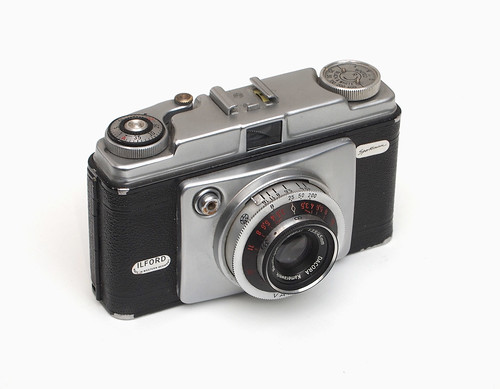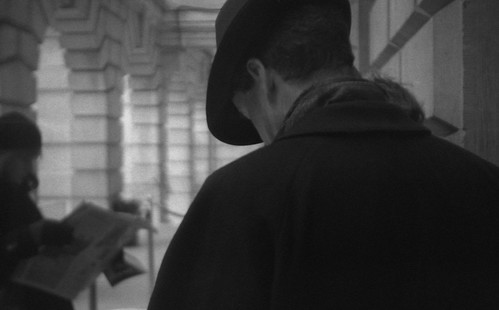 |
| Ilford Sportsman 35mm camera |
This model is the earliest iteration; later Sportsman/Dignette cameras had larger viewfinders, then rangefinders, and selenium cell lightmeters. The camera is of all metal construction, the main section of the solid body appears to be cast, while the top plate and lens/shutter housing are stamped. The lens is a 45mm f3.5 Dacora Dignar, in a Gauthier Vario 3-speed shutter, with speeds of 1/25th, 1/50th, 1/200th and 'B'. The lens focuses down to 3 1/3 feet (for export Dacora simply converted their existing markings in metres to feet), with a depth of field scale around the lens. There is also a PC socket for flash and an accessory shoe on the top plate.
 |
| Ilford Sportsman top view |
The Ilford Sportsman was first marketed in 1957 (the Dacora Dignette itself appeared two years earlier); the manual which came with my camera is dated 1958. There are some very minor variations during the production run of the first body style, notably in the badging: the earliest versions had the word "Foreign" stamped into the leatherette underneath the Ilford name printed in white. This was then replaced by a small metal badge with 'Ilford' and "Made In Western Germany". In 1959 a new version of the Sportsman/Dignette appeared with a redesigned top incorporating a larger viewfinder, a change common to the design of cameras in the late 1950s (a contemporary example being the Vito B, with a larger viewfinder in its 1959 variant).
An interesting curiosity about the Sportsman's Dignar lens is that, although the smallest aperture marked on the camera is f16, the aperture lever goes further, perhaps to f22. The Dacora version of the camera was also available with a faster f2.8 lens. Obviously the aperture lever needs to travel further for the f2,8 lens and as the camera body housing has the same length slot for this lever, with f3.5 as the widest aperture, the slot is wide enough for the aperture lever to move further in the other direction, i.e. to a smaller aperture setting (this is a speculative explanation as I do not have a Dacora Dignette for comparison). The two images below were shot at f16 and the smaller aperture. From the results, any benefits of increased depth of field are offset by the increased and very clear vignetting.
 |
| Exposures of one second at f16, left, and the smaller aperture, right |
 |
| Sample image on Ilfodata HS23 |
 |
| Sample image on Ilfodata HS23 |
 |
| Sample image on Ilford Mark V film |
Sources/further reading
Ilford Sportsman on Photomemorabilia
Peter Wallage's Ilford page
Ilford Sportsman on Camera Wiki
Dacora Dignette on Lippisches Kamera Museum (in German)
Ilford Sportsman in Sylvain Halgand's collection (in French)
Thanks for this about the little Ilford Sportsman. I had one sitting on my desk and gathering dust for six months, at Northampton College where I teach photography. I decided to dust it, stick some of the leatherette back on, clean it up and put a film through it. Keeping my subjects at a distance and not trying to guess the focus, I got good results, if the lens was suitably stopped down. Talking of that, when I was a photographic assistant in London in the 1970s we used 10x8 Ektachrome for all advertising shots, and with the somewhat excellent Schneider Kreuznach lenses capable of f64, 'my' photographer - the wonderful Philip Pace - always said 'stop it hard down', as the aperture control always gave a bit more than f64. Quality on those 10x8 transparencies was always amazing, and my students today are impressed by the quality of some of my own images shot in the format.
ReplyDeleteNick, this was your Grandad's camera through the mid to late 60s - used entirely (as far as I can remember) to take Kodachrome slides.
ReplyDeleteThanks for that piece of information John - I wasn't aware of that. I'd love to see some of the Kodachrome slides some time!
Delete